In this Issue
- Apple’s Auto Team
- Volvo Cars Use Cloud
- MIT: Car-to-Car Tech
- Report from the CEO
- IoT for Car Insurance
- Self-Driving Car Tests
- After Mobile: IoT Opps
- IoT Market 32% CAGR
- Massive Device Mrkt
- Race to Dominate IoT
- Critical to IoT Success
- Will Change Your Life
- Big Data, Personalize
- CIOs & Big Data Tech
- AT&T Patents System
- Big Data Boost: ODP
- Coming DCIA Events
Apple Is Forming an Auto Team
Excerpted from NY Times Report by Brian Chen and Mike Isaac
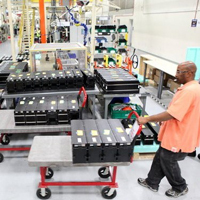 While Apple has been preparing to release its first wearable computers, the company has also been busy assembling a team to work on an automobile.
While Apple has been preparing to release its first wearable computers, the company has also been busy assembling a team to work on an automobile.
The company has collected about 200 people over the last few years — both from inside Apple and potential competitors like Tesla — to develop technologies for an electric car, according to two people with knowledge of the company’s plans, who asked not to be named because the plans were private.
The car project is still in its prototype phase, one person said, meaning it is probably many years away from being a viable product and might never reach the mass market if the quality of the vehicle fails to impress Apple’s executives.
It could also go nowhere if Apple struggles to find a compelling business opportunity in automobiles, a business that typically has much lower sales margins than the products the company currently sells, like the iPhone.
Many of Apple’s newer employees have come from companies that specialize in battery and automotive technologies. Apple has hired many engineers from A123 Systems, Tesla, and Toyota to work on advanced battery technologies.
Apple’s hiring spree of automotive experts more recently accelerated as the company’s plans came into sharper focus. Read more…
Volvo Cars Share Road-Condition Info in the Cloud
Excerpted from EETimes Report by Christoph Hammerschmidt
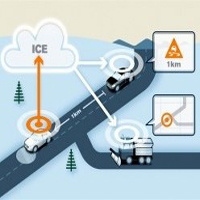 In a joint project, carmaker Volvo, the Swedish Transport Administration, and the Norwegian Public Roads Administration combine V2X communications and cloud-based data storage and processing. The purpose: spreading information about hazardous road conditions as quickly as possible so that icy patches won’t cause accidents anymore.
In a joint project, carmaker Volvo, the Swedish Transport Administration, and the Norwegian Public Roads Administration combine V2X communications and cloud-based data storage and processing. The purpose: spreading information about hazardous road conditions as quickly as possible so that icy patches won’t cause accidents anymore.
Originally started with 50 cars involved, the project has now been expanded to 1,000 vehicles. The engineers have developed a slippery-road alert which notifies drivers about patches of black ice, making winter road maintenance more efficient.
In the vehicles, the alert activates a warning light to notify the drivers if another vehicle in the area has its hazard lights on.
During the course of the project, the group intends to develop further safety features. “This is just the beginning”, said project leader Erik Israelsson. Along with the increase of the test fleet, Volvo plans to broaden the test area to include the cities of Gothenburg (Sweden) and Oslo (Norway). The project also demonstrates the evolution of the car-to-car (or V2V) communications technology:
Developed initially as a means to pass on information between vehicles, it quickly has been expanded to include vehicle-to-roadside communications schemes. The inclusion of the cloud, as realized in the project at hand, is the next logic step. Read more…
MIT: Car-to-Car Communication a Breakthrough Technology
Excerpted from MLive Report by David Muller
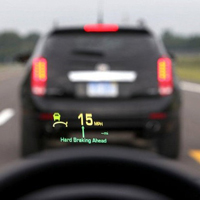 The Massachusetts Institute of Technology’s (MIT) global independent media organization has included car-to-car communication among ten Breakthrough Technologies for 2015, and given General Motors a nod in the process.
The Massachusetts Institute of Technology’s (MIT) global independent media organization has included car-to-car communication among ten Breakthrough Technologies for 2015, and given General Motors a nod in the process.
The MIT Technology Review cited GM’s work at its Warren Research Center in developing the technology, in addition to its commitment to car-to-car tech in a forthcoming, production-model 2017 Cadillac CTS.
The technology journal describes car-to-car communication, also known in the auto world as vehicle-to-vehicle (V2V) technology, as something that could potentially save thousands of lives.
“More than five million crashes occur on US roads alone every year, and more than 30,000 of those are fatal,” MIT Technology Review says. “The prospect of preventing many such accidents will provide significant impetus for networking technology.”
The kind of technology demonstrated to MIT Technology Review came via a Cadillac DTS. The car was able to alert the driver, and prompt him to slam on the brakes, as an oncoming vehicle that was hidden behind a hedge was headed toward him. “Already many cars have instruments that use radar or ultrasound to detect obstacles or vehicles,” says the Review. Read more…
Report from CEO Marty Lafferty
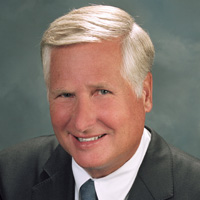 This week, we’re pleased to bring you the fourth installment of the DCIA’s Internet of Things (IoT) Marathon webcast — our distributed computing industry update on IoT — recorded during the 2015 International CES.
This week, we’re pleased to bring you the fourth installment of the DCIA’s Internet of Things (IoT) Marathon webcast — our distributed computing industry update on IoT — recorded during the 2015 International CES.
If you missed the Welcome (play-all) or any of the first three flights of video segments covering Smart Objects for Fitness & Healthcare (play-all), Programmable Homes & Energy Management (play-all), or Media Entertainment & Social Networking Solutions (play-all), please click on the preceding links to screen these parts of the webcast.
Today, you’re cordially invited to view the fourth major section of our webcast, entitled Geolocation Services & Vehicular Automation. Just click here to play the entire episode or click on the links that follow to watch individual segments:
LV Sands Global CIIO Les Ottolenghi delineates the principal terminology for this major section of the webcast in Defining Geolocation Services & Vehicular Automation.
IBM Global Consumer Electronics Director Scott Burnett, IoT Industrial Sector Lead North America Ted Connell, and IoT Foundation Product Manager Neil Postlethwaite provide an overview of How IBM Enables Geolocation Services & Vehicular Automation.
Altman Vilandrie Director Stefan Bewley assesses industry progress on connected, assisted, and driverless cars in Altman Vilandrie – From Connected to Driverless Cars.
Audi Mobile Key Technical Product Manager Roman Kochanek presents the keyless automobile in Audi Mobile Key – Truth in Engineering.
Verizon Telematics VP of Advanced Strategy Tom Taylor discusses the integration of mobile-phone services with connected cars in Verizon Telematics Never Stops Working for You.
Visteon Corporation’s Connected Car Director Mark Zeinstra shows two interrelated in-vehicle cloud-based applications in Visteon Corporation – MyQ Garage & Park Assist.
Royal Technology Advisors President Linda Senigaglia surveys game changers in geolocation services and connected vehicles in Royal Technology Advisors – Game Changers.
Argus Cyber Security VP Marketing Yoni Heilbronn details the Argus IPS security solution for automobiles in partnership with Magna International in Argus Cyber Security – Securing the Connected Car.
CTVA President Scott McCormick covers a range of topics from the origins of the trade group to current automotive industry priorities in Connected Vehicle Trade Association – Industry Viewpoint.
And finally, ChargerLeash Sales Leader Alexis Sheehy demonstrates a solution to one of the connected traveler’s most persistent problems in ChargerLeash – A Traveler’s Must-Have IoT Accessory.
Next week, we’ll bring you a brand new flight of video segments in the next major section of our webcast entitled “Retail, Public Space & Manufacturing Environments.”
Then one week later, we’ll launch the final episode of thematically-linked video segments to complete our industry update on this vital and important technology movement.
To end on a lighter note, here’s an IoT magic video of Simon Pierro’s recent appearance on the Ellen DeGeneres show for your enjoyment. Share wisely, and take care.
Internet of Things Holds Promise for Car Insurance
Excerpted from The Star Report by Adam Mayers
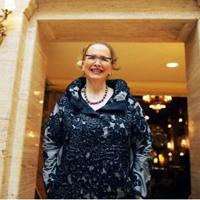 As the Internet of Things (IoT) gets going, one place where Ontario, Canada consumers might see some benefit is in the ever painful cost of car insurance.
As the Internet of Things (IoT) gets going, one place where Ontario, Canada consumers might see some benefit is in the ever painful cost of car insurance.
Here in the Greater Toronto Area (GTA), we pay the most in Canada to insure our vehicles. The average annual charge is about $1,600 per car, about double what it costs in Quebec and the Maritimes.
The reasons are regulations that don’t serve us very well, entrenched interests that resist change, and fraud. An example of the latter: A judge ruled last week that Peel Police Constable Carlton Watson was guilty on more than 40 charges of fraud related to writing false accident reports that passed-off staged car crashes as legitimate.
The IoT is the coming connectivity of common devices, allowing them to send and receive data. It won’t fix Ontario’s insurance mess, but it has the potential to make insurance cheaper by using apps and software that record and transmit your driving habits.
For those who want to opt-in to these programs, the potential savings may be significant. The information you share cannot be used by insurers to raise your premiums, but it can be used to lower them. Read more…
Self-Driving Cars in Real-World Traffic with Real Customers
Excerpted from EETimes Report by Christoph Hammerschmidt
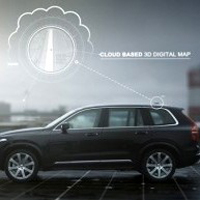 Volvo has provided details of its plan to carry-out a project with 100 self-driving cars in Gothenburg’s real-world traffic. The project reveals which problems autonomous driving will be confronted with.
Volvo has provided details of its plan to carry-out a project with 100 self-driving cars in Gothenburg’s real-world traffic. The project reveals which problems autonomous driving will be confronted with.
Starting in 2017, Volvo will test autonomous driving in a large-scale trial with commuters. The vehicles to be used are latest model XC90 SUVs crammed with sensors. But the project also makes clear that sensors and algorithms in the car are not enough – many success-critical data come from outside the car.
The set of sensors in the self-driving vehicles will be sophisticated: besides a long-range 76GHz radar in the rear-view mirror, the vehicles will have four radars behind the front and rear bumpers, one on each corner of the car.
These radar sensors will detect and locate objects in all directions. By sweeping both left and right, transmitting waves that bounce off signs, poles, and tunnels, they monitor a full 360 degrees around the car.
Four cameras monitor objects in close proximity to the vehicle. Two are under the outer rear-view mirrors, one is in the rear bumper and one is in the grille. Besides detecting objects at close range, these cameras monitor lane markings. These cameras have a high dynamic range and can handle very quick changes in lightning conditions, e.g., when entering a tunnel. Read more…
After Mobile: Three Opportunities for the IoT in 2015
Excerpted from Huffington Post Blog by Sophie-Charlotte Moatti
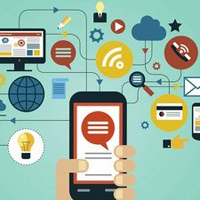 Goldman Sachs predicts that the Internet of Things (IoT) will connect 50 billion devices by 2020. This is no small number compared to the 1 billion PCs and 6 billion mobile phones out there today. But there are many barriers to adoption, including the lack of differentiated platforms, stringent regulatory requirements, and unclear business models.
Goldman Sachs predicts that the Internet of Things (IoT) will connect 50 billion devices by 2020. This is no small number compared to the 1 billion PCs and 6 billion mobile phones out there today. But there are many barriers to adoption, including the lack of differentiated platforms, stringent regulatory requirements, and unclear business models.
Besides, the killer use cases have yet to be identified. Below I’m sharing my perspective on what’s in store for 2015 based on what I’ve learned building an IoT service at Nokia and advising start-ups in that ecosystem.
The recent learnings of wearables devices showed us that a key differentiator of IoT platforms is the consumer experience.
Recent investments from venture capitalists in IoT platforms, such as Electric Imp that raised $15 million in a B-round and Ayla that raised $15 million from Chinese investors, show that the IoT platform war is just starting. It’s too early for the big players such as Honeywell and GE to place their bets, but what will likely make or break the winner(s) are:
Form: including product design, integration in the existing ecosystem, and quality end-to-end solutions. An important technical limitation to overcome s the availability of more precise geo-spatial standard as recommended by the Open Geospatial Consortium. Read more…
Global IoT Market to Grow at 32% CAGR Through 2019
 TechNavio, a tech-focused research firm, has published a new report on the Global Internet of Things (IoT) Market, which is expected to grow at a compounded annual growth rate (CAGR) of 31.72 percent from 2014-2019.
TechNavio, a tech-focused research firm, has published a new report on the Global Internet of Things (IoT) Market, which is expected to grow at a compounded annual growth rate (CAGR) of 31.72 percent from 2014-2019.
The new report draws attention to the increasing number of smart connected devices, which is expected to pass 17 billion in the next five years. All these interconnected devices are becoming increasingly difficult to manage, monitor and maintain, which will increase the demand for M2M and M2H communication.
“M2M allows machines to interact securely over a network. In a broader way, M2M increases IT efficiency for organizations in terms of automated BPM, ERP, and streamlined CRM processes. Since M2M and the IoT are interconnected and interdependent, emergence of M2M will be a huge trend for this market through the projected period,” says Faisal Ghaus, Vice President of TechNavio.
Additionally, the report highlights adoption of IPv6 as another key market trend. The IPv4 system limited network connectivity to 4.3 billion devices, which was not sufficient for the growing number of IoT-connected technology. However, IPv6 has the capacity to handle 3.4×10^38 unique IP addresses, which will facilitate better device management and encourage adoption of the IoT. Read more…
IoT Will Be World’s Most Massive Device Market
Excerpted from Business Insider Report by John Greenough
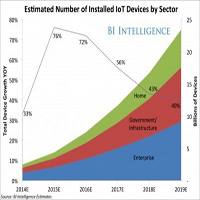 The Internet of Things (IoT) is beginning to grow significantly, as consumers, businesses, and governments recognize the benefit of connecting inert devices to the Internet.
The Internet of Things (IoT) is beginning to grow significantly, as consumers, businesses, and governments recognize the benefit of connecting inert devices to the Internet.
In an all-new report from BI Intelligence, we examine what is currently driving growth in the Internet of Things and how various sectors of the economy will embrace IoT innovations.
Here are a few of the key findings from the BI Intelligence report:
The Internet of Things will be the largest device market in the world. We estimate that by 2019 it will be more than double the size of the smartphone, PC, tablet, connected car, and the wearable market combined.
The IoT will result in $1.7 trillion in value added to the global economy in 2019. This includes hardware, software, installation costs, management services, and economic value added from realized IoT efficiencies.
Device shipments will reach 6.7 billion in 2019 for a five-year CAGR of 61%. Revenue from hardware sales will be only $50 billion or 8% of the total revenue from IoT-specific efforts, as software makers and infrastructure companies will earn the lion’s share. Read more…
The Race to Dominate the Internet of Things
Excerpted from IPWatchdog Report by Gene Quinn
 The Internet of Things (IoT) is the latest catch phrase du jour in the high tech sector, and for good reason. The IoT stole the limelight at the Consumer Electronics Show (CES) with as many as 900 exhibitors in the IoT space.
The Internet of Things (IoT) is the latest catch phrase du jour in the high tech sector, and for good reason. The IoT stole the limelight at the Consumer Electronics Show (CES) with as many as 900 exhibitors in the IoT space.
By 2020, the market for this industry alone is expected to rise to $7.1 trillion. By the year 2050, technology experts predict that there will be 50 billion devices that are connected to the Internet.
But what exactly is the IoT? Cisco Systems says that the IoT “is increasing the connectedness of people and things on a scale that once was unimaginable.” Like many definitions of IoT, this one focuses on the vastness of what is encompassed, without necessarily providing concrete, actionable information.
To some extent that is because the Internet of Things is a concept that best resembles what just a few years ago seemed like science fiction, but today seems to be science reality that promises to change the way that we are connected to and use information. Technology in this sector is advancing so rapidly that it is sometimes difficult to characterize.
The speedy evolution of what defines IoT is why the phrase is frequently called a concept, but it really is much more than that. Read more…
What’s Critical to the Success of the Internet of Things?
Excerpted from Net-Security Report
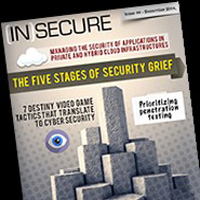 Managing identities and access is critical to the success of the Internet of Things (IoT), but in its current form identity and access management (IAM) cannot provide the scale or manage the complexity that the IoT brings to the enterprise, according to Gartner
Managing identities and access is critical to the success of the Internet of Things (IoT), but in its current form identity and access management (IAM) cannot provide the scale or manage the complexity that the IoT brings to the enterprise, according to Gartner
“IAM leaders must reconsider how traditional approaches to cybersecurity and IAM work in a world where devices and services are so abundant, in so many different forms and positioned at so many different points within the IT ecosystem,” said Earl Perkins, Research Vice President at Gartner.
The growth of the IoT means that IAM leaders of digital businesses require a way of defining and managing the identities of “entities” (people, services, and things) within a single framework.
The IoT is not only about the introduction of different forms of networked devices into digital business moments; it is a transformational approach for viewing and implementing processing, analytics, storage, and communications.
“Traditional, people-focused IAM systems have been unable to accommodate the propagation of devices and things to give a broad and integrated view for IAM leaders,” said Ant Allan, Research Vice President at Gartner. Read more…
The Internet of Things Will Change Your Life
Excerpted from BetaNews Report by Lee Odess
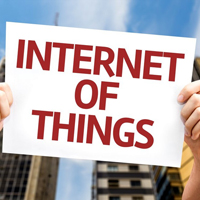 The Internet of Things (IoT) — you may have heard of it in discussions around wearable devices or perhaps just know it as one of the top technology trends of 2014. If you aren’t familiar with the term, be prepared to hear about it a lot this year.
The Internet of Things (IoT) — you may have heard of it in discussions around wearable devices or perhaps just know it as one of the top technology trends of 2014. If you aren’t familiar with the term, be prepared to hear about it a lot this year.
As much as the IoT has become an extremely hot topic for businesses and consumers alike, there is still a chance that you are unsure how it will impact you personally.
While items such as “smart” thermostats and coffee makers sound cool, it’s tough to determine how these products will change the way we live.
Connected devices are already making a significant impact on our lives, whether you know it or not. If you own a smartphone, you’re already contributing to the Internet of Things world.
For example, if you’ve ever used Apple Pay to buy a coffee or the latest tech accessory, you’ve experienced firsthand how your iPhone can “speak” to a payment terminal, sharing your personal information to complete your purchase through pre-authenticated information.
Moving forward, these transactions will become commonplace, cutting down on cash or card purchases. Read more…
The Intersection of Big Data, Personalization, and the IoT
Excerpted from EZ News Report by Bard Farstad
 Recently, we had an internal discussion about the Internet of Things (IoT) that got me thinking. If you aren’t familiar with the term, the basic idea is that all of your day-to-day “things” will be connected to the Internet, giving them the power to connect with each other.
Recently, we had an internal discussion about the Internet of Things (IoT) that got me thinking. If you aren’t familiar with the term, the basic idea is that all of your day-to-day “things” will be connected to the Internet, giving them the power to connect with each other.
But is there really a need to have everything connected to the Internet? You can already buy connected lightbulbs and coffee makers. Do these provide value? Does it really make it simpler to use your phone and a dedicated app to program and set the lighting in your living room? Flicking a switch seems so simple and usable.
Yet, the IoT is already showing benefits in my personal life.
The connections are beginning to take shape around us. My Withings Scale, for instance, tracks my weight among other things, and is connected with the RunKeeper app on my iPhone to track the results of my exercising. By being connected, I gain a fuller picture of my current fitness level.
Another example outside of fitness, is entertainment. Instead of streaming movies and TV shows on phones, tablets and laptops, I can now stream directly from my flat screen TV with devices like Apple TV, Roku, or Google Chromecast. Read more…
The CIO Can’t Afford Ignorance of Big Data Tech
Excerpted from TechRepublic Report by Matt Asay
 The enterprise is awash in Big Data projects. That doesn’t mean, however, that the CIO knows much about them.
The enterprise is awash in Big Data projects. That doesn’t mean, however, that the CIO knows much about them.
In fact, though information technology (IT) leaders are quick to affirm that Big Data is alive and well within their firewalls, they are equally fast to display complete ignorance of how this data is being stored and processed, as a new SnapLogic survey suggests.
While ignorance of IT won’t keep a CIO’s developers from digging into Hadoop, MongoDB, and other Big Data essentials, it does call into question their ongoing relevance to the business.
While developers increasingly run the enterprise asylum, it would be a mistake to believe that this necessarily means the CIO has lost his/her relevance. Today’s IT generally pairs savvy CIOs and developers (often employed by the line of business).
This is one reason IT leaders’ ignorance of Big Data technology is disappointing.
There is a rising percentage of enterprises actively experimenting or running big data deployments, with Hadoop often at their heart, according to Gartner data. Coincidentally, 40% of these same IT leaders expect Hadoop to “play a significant role.” Read more…
AT&T Patents System to “Fast-Lane” BitTorrent Traffic
Excerpted from The Stack Report by Alice MacGregor
 US telecom giant AT&T has been awarded a patent for speeding-up BitTorrent and other peer-to-peer (P2P) traffic, and reducing the impact that these transactions have on the speed of its network.
US telecom giant AT&T has been awarded a patent for speeding-up BitTorrent and other peer-to-peer (P2P) traffic, and reducing the impact that these transactions have on the speed of its network.
File sharing generates thousands of petabytes of downloads every month, sparking considerable concern among the ISP community due to its detrimental effect on network speeds.
In the UK, it was reported last year that Orange throttled roughly 38% of connections, and BT interfered with 35%.
AT&T and its intellectual property (IP) team have targeted the issue in a more positive manner, and appealed for the new patent to create a “fast lane” for BitTorrent and other file-sharing traffic, speeding up transfers and reducing networking costs.
The patent, filed as System and Method to Guide Active Participation in Peer-to-Peer Systems with Passive Monitoring Environment, while outlining the benefits of P2P networks, also points out their impact on greater broadband resources:
“P2P networks can be useful for sharing content files containing audio, video, or other data in digital format.” Read more…
Big Data Boost: Open Data Platform Initiative Unites 15 Tech Giants
Excerpted from CRN Report by Joseph Tsidulk
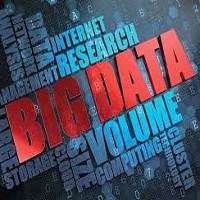 A consortium of fifteen diverse companies launched an initiative Tuesday aiming to define a core platform that will enable faster development and wider enterprise adoption of Big Data projects.
A consortium of fifteen diverse companies launched an initiative Tuesday aiming to define a core platform that will enable faster development and wider enterprise adoption of Big Data projects.
The Open Data Platform, according to the founding members, is an industry association assembled to promote open-source data initiatives, particularly those revolving around the Hadoop analytics framework.
Several Open Data Platform members discussed the project Tuesday in a conference call.
They hailed their collaboration as one that will advance cloud-scale analytics through collaboration and innovation, a boon to developers and end users alike.
Joining Pivotal in the platinum tier of the project’s membership are IBM, Infosys, Hortonworks, SAS, GE, and an international telecom soon to be named. In the Gold tier are Verizon, Teradata, Altiscale, Splunk, CenturyLink, Capgemini, EMC, and VMware.
Those companies, and more they expect to join as the project gains momentum, will develop a common set of APIs and version controls by which they envision an ecosystem growing under Apache licensing governance. Read more…
Coming Events of Interest
Datacloud South East Asia — April 8th-9th in Johor, Malaysia. Datacloud South East Asia will assess the energy, scalability, security, architecture, and software challenges confronting operators of data centers and enterprises engaged in or considering transitions to the cloud.
NAB Show — April 11th-16th in Las Vegas, NV. Popular and fresh attractions for 2015 include the Cloud Pavilion (CP) for asset management; Connected Media Live (CML), focusing on the consumer experience; the Drone Pavilion (DP), featuring a fully enclosed “flying cage” for demonstrations; and the New Media Expo (NMX).
Internet of Things Conference — April 15th-17th in San Diego, CA. The IoT Con will focus on how companies are using a variety of technologies, including ZigBee radios, Wi-Fi, and machine-to-machine (M2M)software, to connect things to the Internet, and how they are achieving real business benefits from doing so.
All That Matters — May 20th-23rd in Singapore. Packed with influencers, content creators, platforms and marketers, ATM drives business and global collaboration for decision makers in the entertainment, media, and marketing industries.
CES Asia — May 25th-27th in Shanghai, China. The success of the 2015 International CES builds strong momentum for CES Asia. With strong exhibitor demand for CEA’s inaugural event, the show will be curated with select qualifying companies permitted to exhibit.
Data Center and Cloud Awards — June 2nd in Monaco. Europe’s most prestigious awards for data center and cloud achievements will be announced at an evening ceremony prior to the opening of Europe’s ‘must-attend’ Datacloud Europe conference and exhibition.
Freescale Technology Forum — June 22nd-25th in Austin, TX. FTF, this year focusing on the Internet of Things (IoT), is the heart of discovery, imagination and innovation. Together we will strategize and design the next market-shifting products.
Internet of Things World Forum (IoTWF) — October (2015 Dates TBD) in Dubai, UAE. IoTWF is an exclusive event that brings together the best and brightest thinkers, practitioners, and innovators from business, government, and academia to accelerate the market adoption of the Internet of Things.
